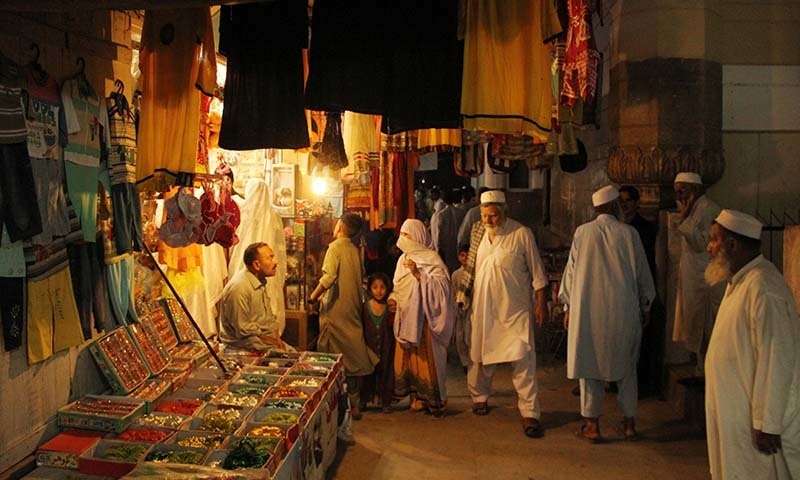 |
| Devotees visit the shrine of Saidu Baba. — Dawn |
MINGORA: Every year scores of tourists from different parts of the country throng picturesque Swat valley, especially in summer season, to enjoy its natural beauty and take refuge from scorching heat.
However, Swat is not only famous for its natural beauty rather it has also many other attractions for the visiting people. One of these attractions in the scenic valley is the shrine of Akhund Abdul Ghaffur alias Saidu Baba. Situated in courtyard of white marbled Saidu Baba Mosque, the shrine is thronged by people in droves from across the country.
Saidu Baba, an influential religious leader of the region, played fundamental role in formation of modern Swat state. He was born at Jabrhi village in Shamizai area of Swat valley in 1784 and died in 1877. However, researchers differ over his date of birth. Some says he was born in 1793 while others have mentioned 1794 as his year of birth.
 |
| Saidu Baba Tomb. — Dawn |
A staunch supporter of Emir Dost Mohammad Khan of Afghanistan, Saidu Baba was strongly opposed to the Sikh and British forces. According to some researchers, he led Yousafzai and other tribes in the battle of Ambela Pass in 1863 against the British forces. However, some historians claim that his policy towards the imperialist power was conciliatory and submissive.
People from across the country visit shrine of Saidu Baba in droves to seek peace of mind
Saidu Baba has been praised by Muslim leaders and English writers alike. His love for freedom, strong character, bravery and far-sightedness were praised by Syed Jamaludin Afghani in his book, Al Bayan, while Hughes, a famous Christian missionary, also lauded him. George T Lanigan wrote a poem on the death of Saidu Baba in 1877.
That’s why the area where he is buried is called Saidu Sharif. Sharif means ‘holy’.
A large number of visitors and devotees visit his shrine, some to find solace, some to get their prayers answered and others to see its historical grandeur.
 |
| Personal belongings of Saidu Baba. — Dawn |
“We first visited the scenic spots in Swat valley and then came here to receive blessings. Saidu Baba is considered a respectable personality of the area who not only preached Islam but also worked against the non-Muslim forces in the region,” said Nasimullah, a visitor from Chakdara.
Accompanied by a group of youth, he was proud to see some of the belongings of Saidu Baba.
A family from Peshawar was also among hundreds of pilgrims at the shrine. The members of the family said that they spent over a month in Swat but found peace of mind when they visited the tomb of the great saint.
“We had heard a lot about Saidu Baba and his blessings and today it proved that we got happiness and blessings of soul here,” said Mohammad Amir Awan.
 |
| Inside of Saidu Baba mosque. — Dawn |
“We have visited every corner of Swat valley, every scenic spot of the beautiful valley but it gave us nothing except solace to eyes. However, when we entered the tomb here we immediately felt something internal, the solace of heart and mind,” the wife of Mr Awan told Dawn.
She said that every visitor to the valley must pay a visit to the shrine as Saidu Baba was one of Allah’s favourite persons.
Bacha Khan, 50, a caretaker of the shrine, said that thousands of people came there to pray and went back happily as their prayers were answered immediately. “I have found the real joy of life and satisfaction since I have come here and left the worldly affairs,” he said.
Faridoon, an elder who lives closer to Saidu Baba shrine, said that there were different timings for different people to visit the tomb.
 |
| Saidu Baba Mosque and Tomb. — Dawn |
“Famers from different areas including Bannu, Miramhah and Thaal visit the shrine from May to April. They go back on Friday after staying for Thursday night. The second batch of pilgrims visits the shrine in the months of June, July and August. They mostly come from Punjab province. They stay for four to five days at the tomb. The third group is of those people, who visit the tomb during Eid days. It is the largest of all groups,” he said.
Mr Faridoon said that local people also welcomed the visitors and took care of them.
Apart from the tomb of Saidu Baba, the classic architecture of Islamic style constructed in 1943 in the Swat state era is also worth seeing. “The white marble and wooden carvings used in pillars are amazing. The large dome, surrounded by four minarets, attracts onlookers from far and wide,” said Amjad Ali, a resident of Mingora.
There is a small but beautiful bazaar, mainly for women, just in front of the Saidu Baba Mosque where women from surrounding areas come for shopping.
 |
| Saidu Baba Bazaar. — Dawn |
Published in Dawn, July 24th, 2015
On a mobile phone? Get the Dawn Mobile App: Apple Store | Google Play












































